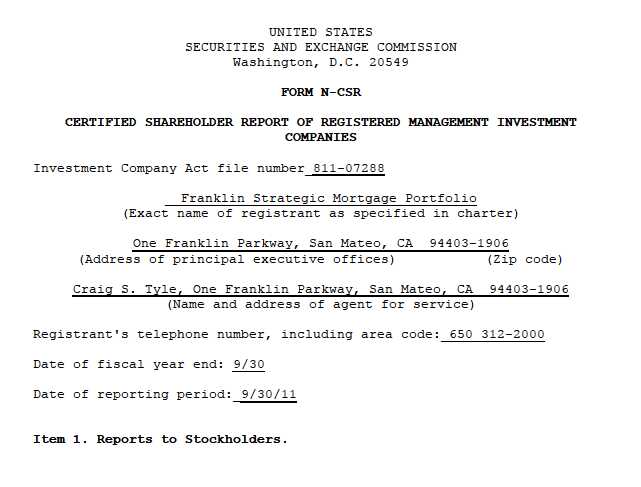
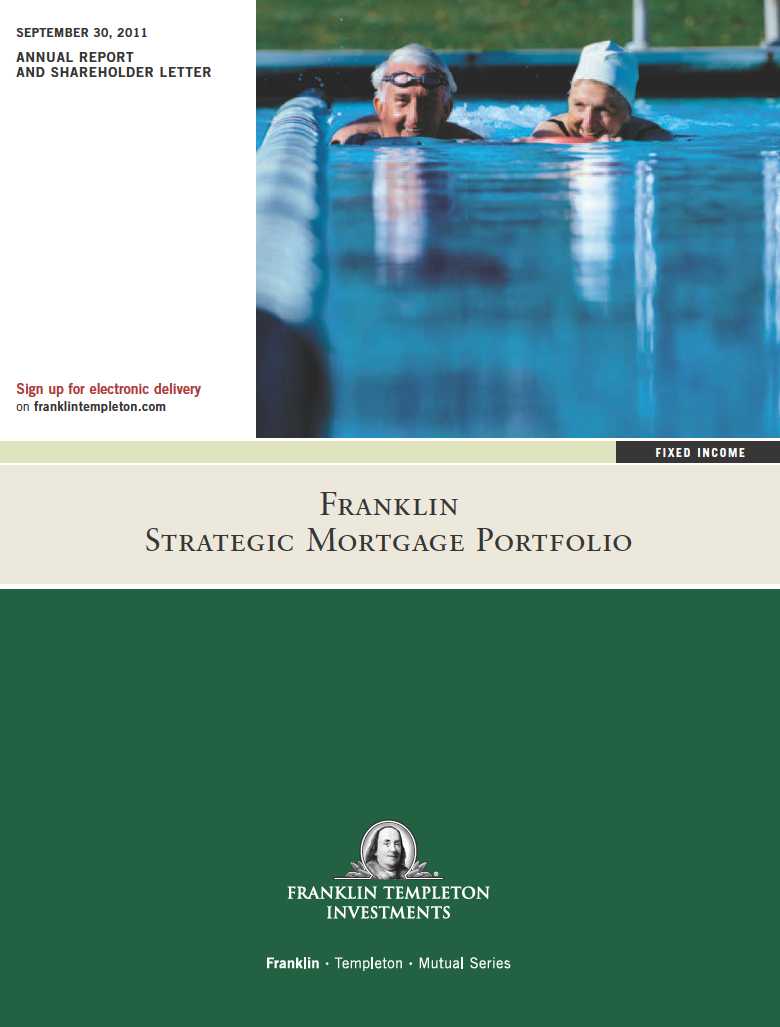

Annual Report
Franklin Strategic Mortgage Portfolio
Your Fund’s Goal and Main Investments: Franklin Strategic Mortgage Portfolio seeks high total return (a combination of high current income and capital appreciation) relative to the performance of the general mortgage securities market by investing at least 80% of its net assets in a portfolio of mortgage securities. The Fund normally focuses its investments in mortgage pass-through securities, which are securities representing interests in “pools” of mortgage loans issued or guaranteed by the U.S. government, its agencies or instrumentalities. Some of the Fund’s investments may include securities issued by government-sponsored entities, such as Fannie Mae and Freddie Mac.1
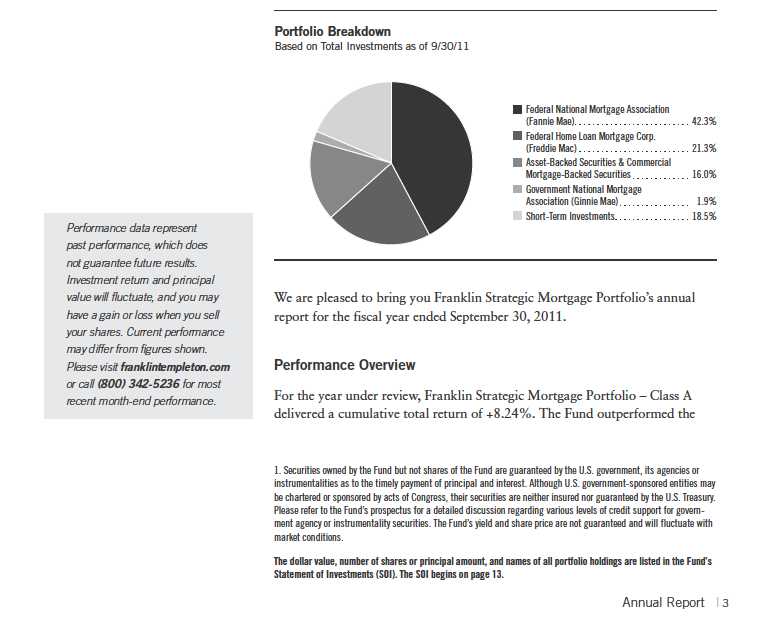
+5.66% total return of its benchmark, the Citigroup U.S. Broad Investment-Grade (USBIG) Mortgage Index, which is the mortgage component of the Citigroup USBIG Bond Index.2 For comparison, the Lipper U.S. Mortgage Funds Classification Average, which consists of funds chosen by Lipper that invest primarily in mortgages and securities issued or guaranteed by the U.S. government and certain federal agencies,1 returned +5.22%.3 The Barclays Capital (BC) U.S. Treasury Index, the U.S. Treasury component of the BC U.S. Government Index, posted a +5.97% total return.4 You can find the Fund’s long-term performance data in the Performance Summary beginning on page 8.
Economic and Market Overview
During the fiscal year under review, Federal Reserve Board (Fed) policymakers maintained historically low interest rates while adopting a more restrained view of the economy largely because of developments in Europe and signs the U.S. economic expansion lacked momentum. To promote a stronger recovery and help maintain inflation levels the Fed believed consistent with its dual mandate to foster maximum employment and price stability, the Fed undertook a second round of quantitative easing consisting of a $600 billion purchase of longer term U.S. Treasuries, which ended on June 30. Subsequently, the Fed continued to purchase U.S. Treasuries with proceeds from maturing debt in an effort to support economic growth.
Despite the Fed’s actions, the economy grew more slowly than expected. Housing market weakness continued and unemployment remained high. After showing solid improvement through the first half of the reporting period, manufacturing activity weakened partly because of global supply-chain disruptions following Japan’s natural disasters. Geopolitical instability in some oil-producing regions drove up oil prices for much of the period. However, investor concerns over weak economic data caused crude oil prices to drop from their 12-month high of $114 per barrel on April 29 to $79 at period-end. Storms and droughts in several states reduced crop yields, pushing up grain prices. As oil and food prices rose, the pace of inflation accelerated during the period.
2. Source: © 2011 Morningstar. All Rights Reserved. The information contained herein: (1) is proprietary to Morningstar and/or its content providers; (2) may not be copied or distributed; and (3) is not warranted to be accurate, complete or timely. Neither Morningstar nor its content providers are responsible for any damages or losses arising from any use of this information.
3. Source: Lipper Inc. For the six-month period ended 9/30/11, this category consisted of 92 funds. Lipper calculations do not include sales charges or subsidization by a fund’s manager. The Fund’s performance relative to the average might have differed if these or other factors had been considered.
4. Source: © 2011 Morningstar. Treasuries, if held to maturity, offer a fixed rate of return and fixed principal value; their interest payments and principal are guaranteed. The Fund’s investment return and share price fluctuate with market conditions.
The indexes are unmanaged and include reinvestment of any income or distributions. One cannot invest directly in an index, and an index is not representative of the Fund’s portfolio.
4 | Annual Report

some analysts believe it could support the MBS sector. Prepayment risk remained heightened during the review period largely due to historically low mortgage rates, although overall prepayment activity gradually declined. In our view, however, a possible expansion to the Home Affordable Refinance Program (HARP), which covers mortgages owned or guaranteed by Fannie Mae or Freddie Mac, could increase the number of borrowers eligible to refinance their homes. Although a HARP expansion could be positive for U.S. household finances, it could negatively affect related MBS security valuations.
As measured by BC indexes, most fixed income sectors posted positive returns, but the increased volatility and uncertainty during the period led most fixed income sectors to trail the strong performance of U.S. Treasuries. U.S. Treasuries posted some of the best absolute performance during the period, followed by U.S. residential MBS, commercial MBS (CMBS) and asset-backed securities (ABS).
The Fund used a broad mortgage strategy that looked across all mortgage opportunity sets to find relative value, and our investment process and strategy did not change. The management team continued to look for strong cash flow fundamentals and valuations to uncover opportunities across the mortgage investment universe.
Although prepayment risk remained heightened, actual prepayment levels were constrained and generally slowed due to the associated cost of refinancing, loss of home equity, tighter underwriting standards and declining home prices. In this environment, we increased the Fund’s exposure to lower coupon MBS (4.0% and 4.5%). Our heaviest allocation was in 4.5% and 5.0% coupons at period-end.
We modestly decreased exposure to the ABS sector. We swapped out of super-senior securities, which delivered strong performance and price appreciation. Within securitized sectors, our emphasis remained on higher quality securities that had higher seniority in the capital structure and benefited from strong levels of credit protection. We remained allocated to CMBS, and credit fundamentals showed some signs of stabilization. We believe, however, the commercial real estate environment could remain challenged over the intermediate term. The majority of the Fund’s CMBS allocations was high in the capital structure and generally benefited from high levels of credit protection, which could help them weather negative real estate environments. The Fund’s CMBS exposure was a significant contributor to performance over the period. Our sector allocation to MBS and non-agency residential MBS also aided performance. The Fund’s yield curve positioning detracted from returns after interest rate movements negatively impacted performance.
6 | Annual Report
Thank you for your continued participation in Franklin Strategic Mortgage Portfolio. We look forward to serving your future investment needs.

The foregoing information reflects our analysis, opinions and portfolio holdings as of September 30, 2011, the end of the reporting period. The way we implement our main investment strategies and the resulting portfolio holdings may change depending on factors such as market and economic conditions. These opinions may not be relied upon as investment advice or an offer for a particular security. The information is not a complete analysis of every aspect of any market, country, industry, security or the Fund. Statements of fact are from sources considered reliable, but the investment manager makes no representation or warranty as to their completeness or accuracy. Although historical performance is no guarantee of future results, these insights may help you understand our investment management philosophy.
Annual Report | 7
Performance Summary as of 9/30/11
Your dividend income will vary depending on dividends or interest paid by securities in the Fund’s portfolio, adjusted for operating expenses. Capital gain distributions are net profits realized from the sale of portfolio securities. The performance table and graph do not reflect any taxes that a shareholder would pay on Fund dividends, capital gain distributions, if any, or any realized gains on the sale of Fund shares. Total return reflects reinvestment of the Fund’s dividends and capital gain distributions, if any, and any unrealized gains or losses.
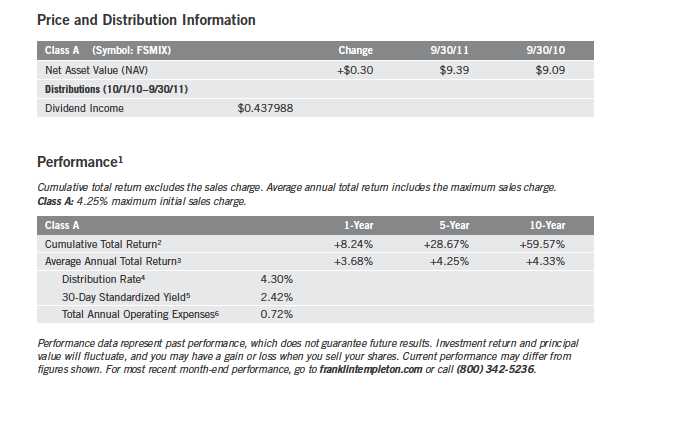
8 | Annual Report
Performance Summary (continued)
Total Return Index Comparison for a Hypothetical $10,000 Investment1
Total return represents the change in value of an investment over the periods shown. It includes the applicable maximum sales charge, Fund expenses, account fees and reinvested distributions. The unmanaged index includes reinvestment of any income or distributions. It differs from the Fund in composition and does not pay management fees or expenses. One cannot invest directly in an index.
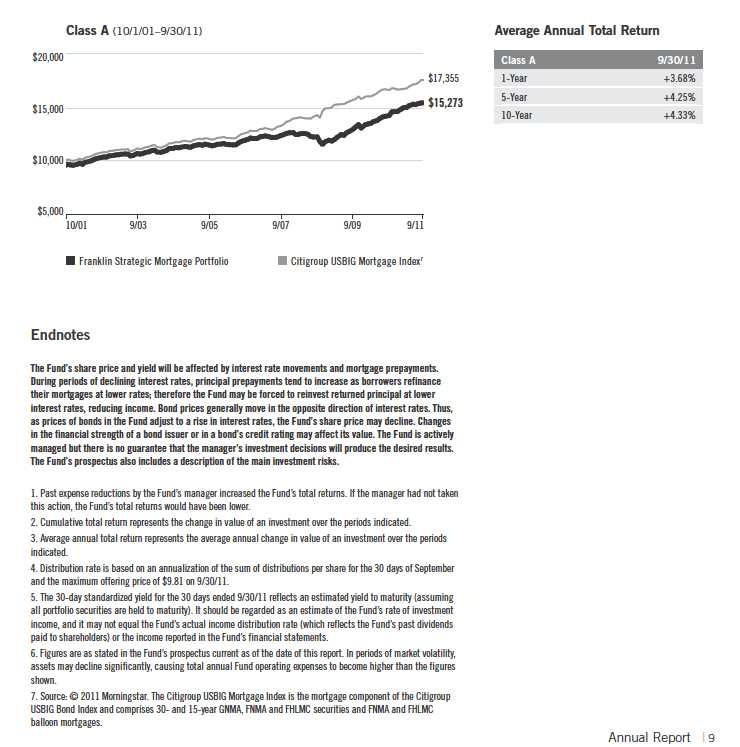
Your Fund’s Expenses
As a Fund shareholder, you can incur two types of costs:
- Transaction costs, including sales charges (loads) on Fund purchases; and
- Ongoing Fund costs, including management fees, distribution and service (12b-1) fees, and other Fund expenses. All mutual funds have ongoing costs, sometimes referred to as operating expenses.
The following table shows ongoing costs of investing in the Fund and can help you understand these costs and compare them with those of other mutual funds. The table assumes a $1,000 investment held for the six months indicated.
Actual Fund Expenses
The first line (Actual) for each share class listed in the table provides actual account values and expenses. The “Ending Account Value” is derived from the Fund’s actual return, which includes the effect of Fund expenses.
You can estimate the expenses you paid during the period by following these steps. Of course, your account value and expenses will differ from those in this illustration:
| 1. | Divide your account value by $1,000. |
| If an account had an $8,600 value, then $8,600 ÷ $1,000 = 8.6. | |
| 2. | Multiply the result by the number under the heading “Expenses Paid During Period.” |
| If Expenses Paid During Period were $7.50, then 8.6 x $7.50 = $64.50. |
In this illustration, the estimated expenses paid this period are $64.50.
Hypothetical Example for Comparison with Other Funds
Information in the second line (Hypothetical) for each class in the table can help you compare ongoing costs of investing in the Fund with those of other mutual funds. This information may not be used to estimate the actual ending account balance or expenses you paid during the period. The hypothetical “Ending Account Value” is based on the actual expense ratio for each class and an assumed 5% annual rate of return before expenses, which does not represent the Fund’s actual return. The figure under the heading “Expenses Paid During Period” shows the hypothetical expenses your account would have incurred under this scenario. You can compare this figure with the 5% hypothetical examples that appear in shareholder reports of other funds.
10 | Annual Report
Your Fund’s Expenses (continued)
Please note that expenses shown in the table are meant to highlight ongoing costs and do not reflect any transaction costs, such as sales charges. Therefore, the second line for each class is useful in comparing ongoing costs only, and will not help you compare total costs of owning different funds. In addition, if transaction costs were included, your total costs would have been higher. Please refer to the Fund prospectus for additional information on operating expenses.

Annual Report | 11
Franklin Strategic Mortgage Portfolio
Financial Highlights
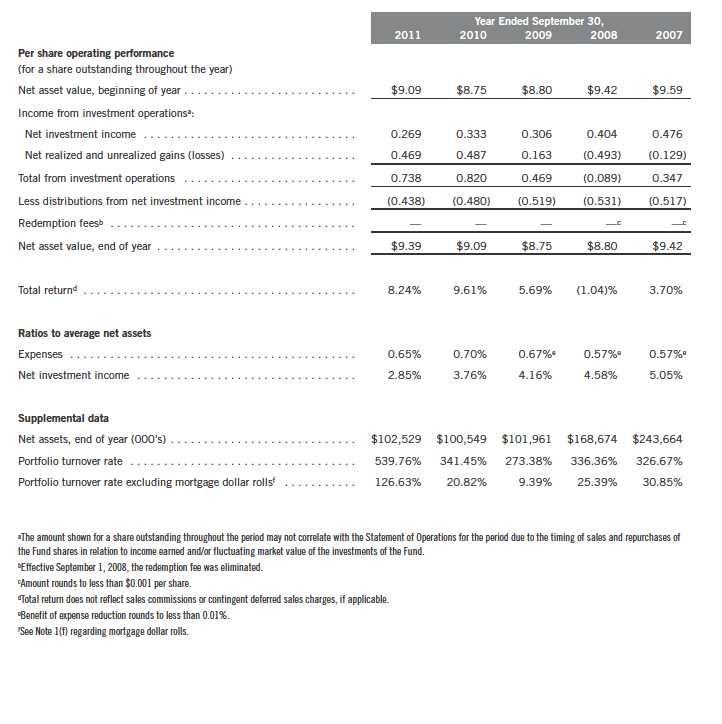
12 | The accompanying notes are an integral part of these financial statements. | Annual Report
Franklin Strategic Mortgage Portfolio
Statement of Investments, September 30, 2011
| Principal Amount* | Value | |||
| Asset-Backed Securities and Commercial Mortgage-Backed Securities 23.5% | ||||
| Finance 23.5% | ||||
| aAFC Home Equity Loan Trust, 1997-4, 2A2, 0.875%, 12/22/27 | 265,235 | $ | 211,309 | |
| aAmeriquest Mortgage Securities Inc., 2003-12, M2, 2.785%, 1/25/34 | 760,684 | 386,530 | ||
| Banc of America Commercial Mortgage Inc., | ||||
| 2006-1, AJ, 5.46%, 9/10/45 | 1,000,000 | 813,132 | ||
| 2006-1, AM, 5.421%, 9/10/45 | 1,100,000 | 1,105,609 | ||
| 2006-4, AJ, 5.695%, 7/10/46 | 250,000 | 190,427 | ||
| 2006-4, AM, 5.675%, 7/10/46 | 300,000 | 280,937 | ||
| a,bBanc of America Large Loan, 2010-HLTN, 144A, 1.979%, 11/15/15 | 1,159,438 | 1,035,100 | ||
| a,bBayview Commercial Asset Trust, 2006-CD1A, A-1, 144A, 1.489%, 7/25/23 (Canada) | 418,870 | CAD | 393,692 | |
| aBear Stearns Alt-A Trust, 2004-13, A2, 1.115%, 11/25/34 | 419,091 | 294,705 | ||
| Bear Stearns Commercial Mortgage Securities Inc., | ||||
| a,b2006-PW11, D, 144A, 5.452%, 3/11/39 | 500,000 | 246,275 | ||
| 2006-PW13, AJ, 5.611%, 9/11/41 | 750,000 | 587,017 | ||
| CitiFinancial Mortgage Securities Inc., 2003-4, AF6, 4.493%, 10/25/33 | 1,237,583 | 1,194,100 | ||
| aCitigroup Commercial Mortgage Trust, 2007-C6, AM, 5.697%, 6/10/17 | 500,000 | 458,196 | ||
| aCitigroup/Deutsche Bank Commercial Mortgage Trust, | ||||
| 2005-CD1, AJ, 5.226%, 7/15/44 | 500,000 | 399,388 | ||
| 2006-CD3, AJ, 5.688%, 10/15/48 | 450,000 | 238,646 | ||
| Commercial Mortgage Pass-through Certificate, 2005-C6, AJ, 5.209%, 6/10/44 | 500,000 | 435,747 | ||
| Countrywide Home Loans, 2004-J8, 3A3, 5.50%, 12/25/34 | 56,812 | 57,415 | ||
| a,bCredit Suisse Mortgage Capital Certificates, 2006-TF2A, A2, 144A, 0.399%, | ||||
| 10/15/21 | 226,796 | 209,970 | ||
| aFirst Franklin Mortgage Loan Asset-Backed Certificates, 2004-FF11, 1A2, 0.585%, 1/25/35 | 280,716 | 265,885 | ||
| FNMA, | ||||
| a2007-1, NF, 0.485%, 2/25/37 | 588,590 | 585,943 | ||
| G93-33, K, 7.00%, 9/25/23 | 1,146,481 | 1,303,335 | ||
| GMAC Commercial Mortgage Securities Inc., 2005-C1, B, 4.936%, 5/10/43 | 800,000 | 603,673 | ||
| aGS Mortgage Securities Corp. II, 2007-GG10, A4, 5.79%, 8/10/45 | 1,000,000 | 1,043,220 | ||
| aHome Equity Mortgage Trust, 2004-4, M3, 1.21%, 12/25/34 | 623,352 | 451,138 | ||
| aHomebanc Mortgage Trust, 2005-4, A1, 0.505%, 10/25/35 | 213,444 | 141,041 | ||
| aJPMorgan Chase Commercial Mortgage Securities Corp., 2006-CB14, | ||||
| AM, 5.542%, 12/12/44 | 1,000,000 | 936,914 | ||
| B, 5.452%, 12/12/44 | 1,000,000 | 485,523 | ||
| LB-UBS Commercial Mortgage Trust, 2006-C6, AJ, 5.452%, 9/15/39 | 500,000 | 389,045 | ||
| Lehman ABS Corp., 2003-1, A1, 5.00%, 12/25/33 | 1,340,108 | 1,376,065 | ||
| aMerrill Lynch Mortgage Investors Inc., 2003-A, 1A, 0.975%, 3/25/28 | 716,593 | 619,355 | ||
| aMorgan Stanley ABS Capital I Inc. Trust, | ||||
| 2003-HE1, M1, 1.435%, 5/25/33 | 669,338 | 544,439 | ||
| 2005-WMC, M2, 0.97%, 1/25/35 | 500,000 | 396,814 | ||
| aMorgan Stanley Capital I Trust, 2004-IQ7, A4, 5.48%, 6/15/38 | 2,050,000 | 2,197,577 | ||
| aNovastar Home Equity Loan, 2004-4, M4, 1.885%, 3/25/35 | 1,500,000 | 1,127,572 | ||
| Residential Asset Securities Corp., | ||||
| 2004-KS1, AI4, 4.213%, 4/25/32 | 356,027 | 347,733 | ||
| a2005-AHL2, A2, 0.495%, 10/25/35 | 69,825 | 65,212 | ||
| a,bStructured Asset Securities Corp., 2005-SC1, 1A1, 144A, 0.505%, 5/25/31 | 605,193 | 270,408 | ||
| aTravelers Mortgage Services Inc., 1998-5A, A, 2.469%, 12/25/18 | 70,478 | 70,018 | ||
Annual Report | 13
Franklin Strategic Mortgage Portfolio
Statement of Investments, September 30, 2011 (continued)
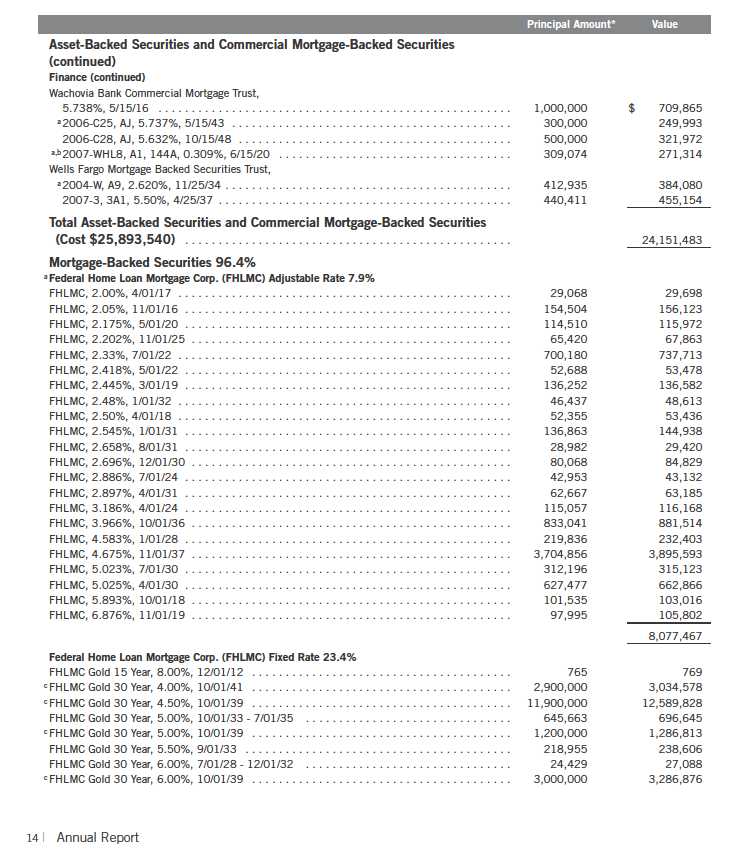
Franklin Strategic Mortgage Portfolio
Statement of Investments, September 30, 2011 (continued)
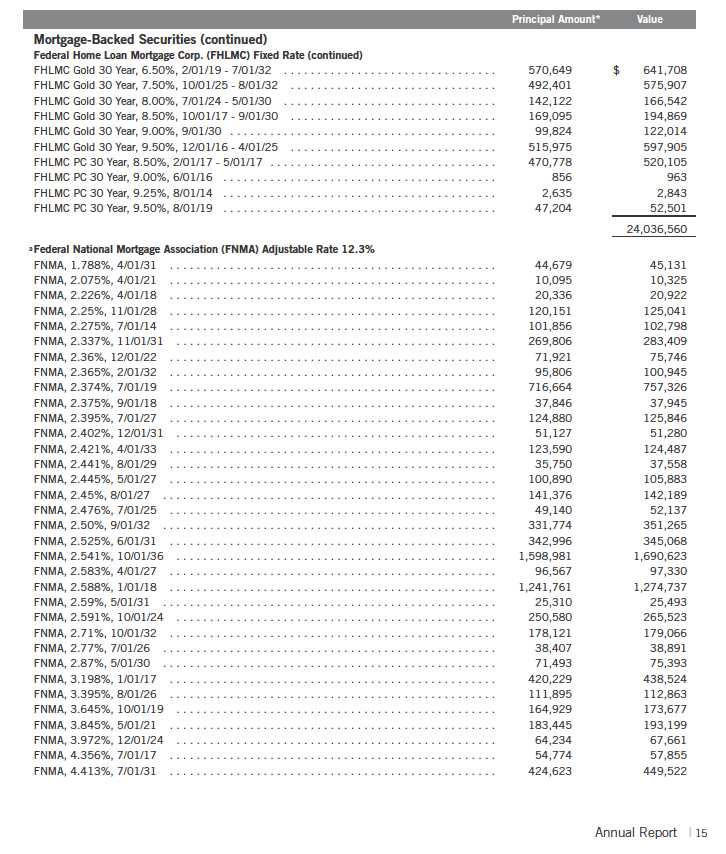
Franklin Strategic Mortgage Portfolio
Statement of Investments, September 30, 2011 (continued)
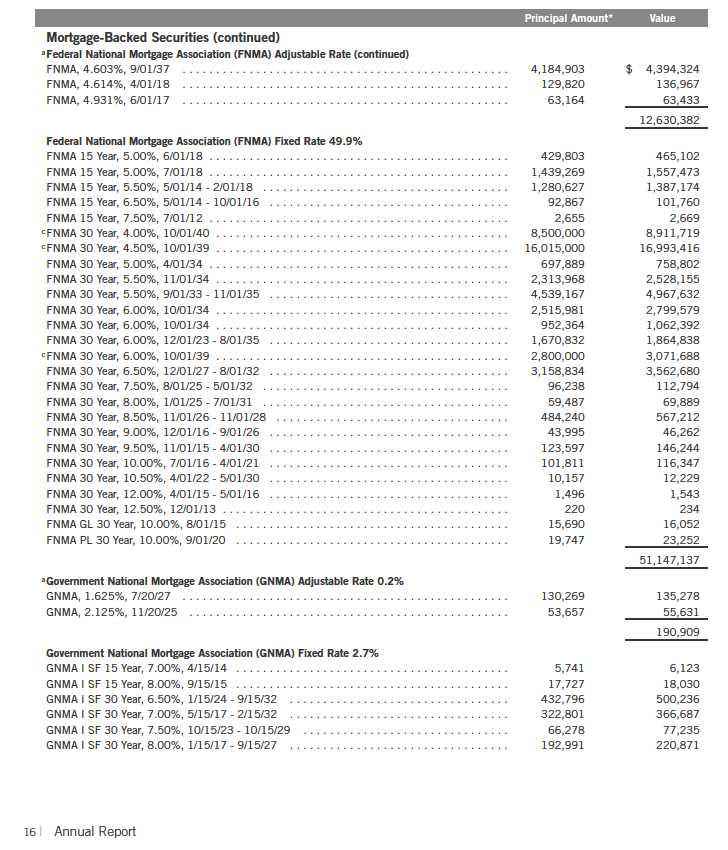
Franklin Strategic Mortgage Portfolio
Statement of Investments, September 30, 2011 (continued)
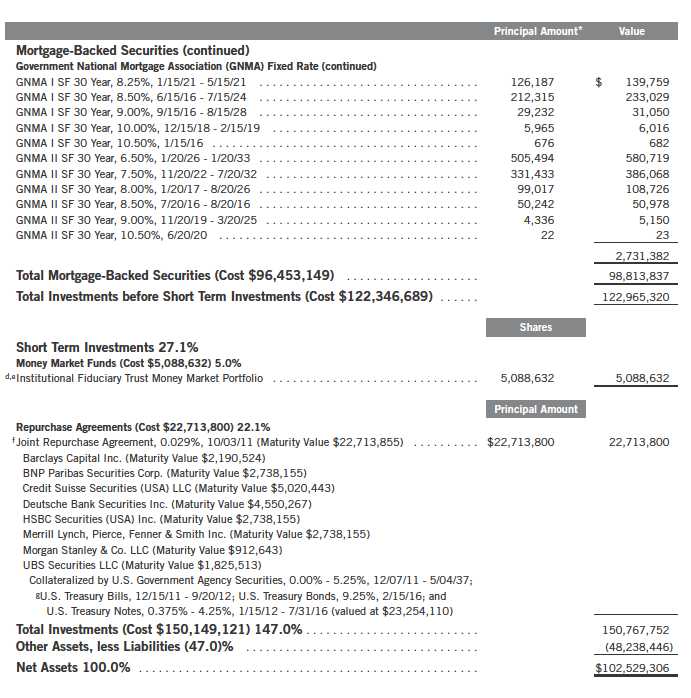
Annual Report | 17
| Franklin Strategic Mortgage Portfolio |
| Statement of Investments, September 30, 2011 (continued) |
| *The principal amount is stated in U.S. dollars unless otherwise indicated. |
| aThe coupon rate shown represents the rate at period end. |
| bSecurity was purchased pursuant to Rule 144A under the Securities Act of 1933 and may be sold in transactions exempt from registration only to qualified institutional buyers or in |
| a public offering registered under the Securities Act of 1933. These securities have been deemed liquid under guidelines approved by the Fund’s Board of Trustees. At September 30, |
| 2011, the aggregate value of these securities was $2,426,759, representing 2.37% of net assets. |
| cSecurity purchased on a to-be-announced (TBA) basis. See Note 1(d). |
| dNon-income producing. |
| eSee Note 7 regarding investments in the Institutional Fiduciary Trust Money Market Portfolio. |
| fSee Note 1(c) regarding joint repurchase agreement. |
| gThe security is traded on a discount basis with no stated coupon rate. |

18 | The accompanying notes are an integral part of these financial statements. | Annual Report
Franklin Strategic Mortgage Portfolio
Financial Statements
Statement of Assets and Liabilities
September 30, 2011
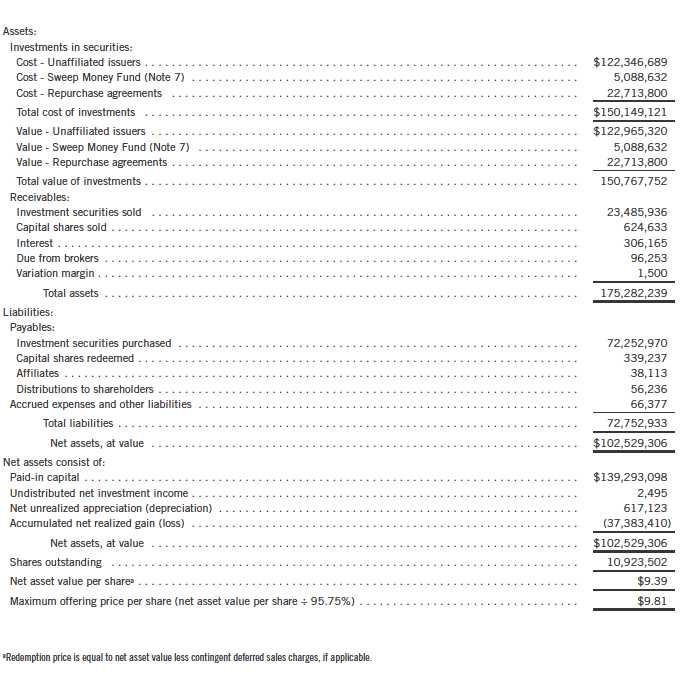
Annual Report | The accompanying notes are an integral part of these financial statements. | 19
Franklin Strategic Mortgage Portfolio
Financial Statements (continued)
Statement of Operations
for the year ended September 30, 2011
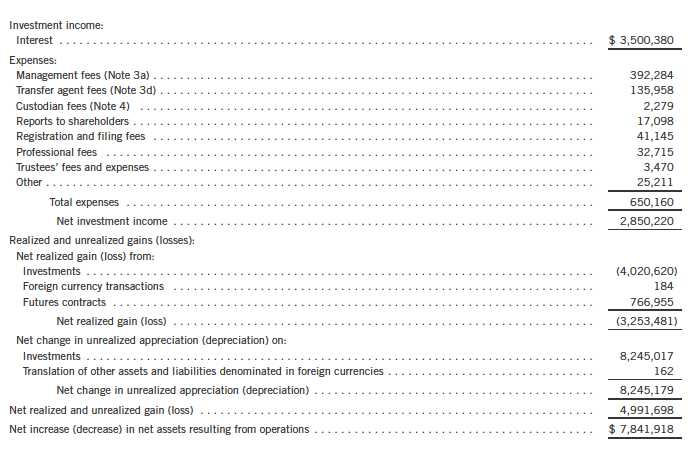
20 | The accompanying notes are an integral part of these financial statements. | Annual Report
Franklin Strategic Mortgage Portfolio
Financial Statements (continued)
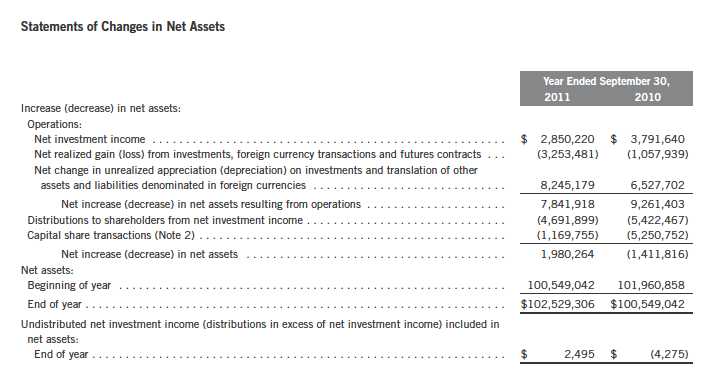
Annual Report | The accompanying notes are an integral part of these financial statements. | 21
Franklin Strategic Mortgage Portfolio
Notes to Financial Statements
1. ORGANIZATION AND SIGNIFICANT ACCOUNTING POLICIES
Franklin Strategic Mortgage Portfolio (Trust) is registered under the Investment Company Act of 1940, as amended, (1940 Act) as an open-end investment company, consisting of one fund, the Franklin Strategic Mortgage Portfolio (Fund).
The following summarizes the Fund’s significant accounting policies.
a. Financial Instrument Valuation
The Fund’s investments in securities and other financial instruments are carried at fair value daily. Fair value is the price that would be received to sell an asset or paid to transfer a liability in an orderly transaction between market participants on the measurement date. Under procedures approved by the Fund’s Board of Trustees, the Fund may utilize independent pricing services, quotations from securities and financial instrument dealers, and other market sources to determine fair value.
Debt securities generally trade in the over-the-counter market rather than on a securities exchange. The Fund’s pricing services use multiple valuation techniques to determine fair value. In instances where sufficient market activity exists, the pricing services may utilize a market-based approach through which quotes from market makers are used to determine fair value. In instances where sufficient market activity may not exist or is limited, the pricing services also utilize proprietary valuation models which may consider market characteristics such as benchmark yield curves, option-adjusted spreads, credit spreads, estimated default rates, coupon rates, anticipated timing of principal repayments, underlying collateral, and other unique security features in order to estimate the relevant cash flows, which are then discounted to calculate the fair value. Securities denominated in a foreign currency are converted into their U.S. dollar equivalent at the foreign exchange rate in effect at the close of the NYSE on the date that the values of the foreign debt securities are determined. Derivative financial instruments (derivatives) listed on an exchange are valued at the official closing price of the day. Investments in open-end mutual funds are valued at the closing net asset value. Repurchase agreements are valued at cost, which approximates market value.
The Fund has procedures to determine the fair value of securities and other financial instruments for which market prices are not readily available or which may not be reliably priced. Under these procedures, the Fund primarily employs a market-based approach which may use related or comparable assets or liabilities, recent transactions, market multiples, book values, and other relevant information for the investment to determine the fair value of the investment. The Fund may also use an income-based valuation approach in which the anticipated future cash flows of the investment are discounted to calculate fair value. Discounts may also be applied due to the nature or duration of any restrictions on the disposition of the investments. Due to the inherent uncertainty of valuations of such investments, the fair values may differ significantly from the values that would have been used had an active market existed.
22 | Annual Report
Franklin Strategic Mortgage Portfolio
Notes to Financial Statements (continued)
| 1. | ORGANIZATION AND SIGNIFICANT ACCOUNTING POLICIES (continued) |
| b. | Foreign Currency Translation |
Portfolio securities and other assets and liabilities denominated in foreign currencies are translated into U.S. dollars based on the exchange rate of such currencies against U.S. dollars on the date of valuation. The Fund may enter into foreign currency exchange contracts to facilitate transactions denominated in a foreign currency. Purchases and sales of securities, income and expense items denominated in foreign currencies are translated into U.S. dollars at the exchange rate in effect on the transaction date. Portfolio securities and assets and liabilities denominated in foreign currencies contain risks that those currencies will decline in value relative to the U.S. dollar. Occasionally, events may impact the availability or reliability of foreign exchange rates used to convert the U.S. dollar equivalent value. If such an event occurs, the foreign exchange rate will be valued at fair value using procedures established and approved by the Fund’s Board of Trustees.
The Fund does not separately report the effect of changes in foreign exchange rates from changes in market prices on securities held. Such changes are included in net realized and unrealized gain or loss from investments on the Statement of Operations.
Realized foreign exchange gains or losses arise from sales of foreign currencies, currency gains or losses realized between the trade and settlement dates on securities transactions and the difference between the recorded amounts of dividends, interest, and foreign withholding taxes and the U.S. dollar equivalent of the amounts actually received or paid. Net unrealized foreign exchange gains and losses arise from changes in foreign exchange rates on foreign denominated assets and liabilities other than investments in securities held at the end of the reporting period.
c. Joint Repurchase Agreement
The Fund enters into a joint repurchase agreement whereby its uninvested cash balance is deposited into a joint cash account with other funds managed by the investment manager or an affiliate of the investment manager and is used to invest in one or more repurchase agreements. The value and face amount of the joint repurchase agreement are allocated to the funds based on their pro-rata interest. A repurchase agreement is accounted for as a loan by the fund to the seller, collateralized by securities which are delivered to the fund’s custodian. The market value, including accrued interest, of the initial collateralization is required to be at least 102% of the dollar amount invested by the funds, with the value of the underlying securities marked to market daily to maintain coverage of at least 100%. The joint repurchase agreement held by the Fund at year end had been entered into on September 30, 2011.
d. Securities Purchased on a TBA Basis
The Fund purchases securities on a to-be-announced (TBA) basis, with payment and delivery scheduled for a future date. These transactions are subject to market fluctuations and are subject to the risk that the value at delivery may be more or less than the trade date purchase price.
Annual Report | 23
Franklin Strategic Mortgage Portfolio
Notes to Financial Statements (continued)
| 1. | ORGANIZATION AND SIGNIFICANT ACCOUNTING POLICIES (continued) |
| d. | Securities Purchased on a TBA Basis (continued) |
Although the Fund will generally purchase these securities with the intention of holding the securities, it may sell the securities before the settlement date. Sufficient assets have been segregated for these securities.
e. Derivative Financial Instruments
The Fund invested in derivatives in order to manage risk or gain exposure to various other investments or markets. Derivatives are financial contracts based on an underlying or notional amount, require no initial investment or an initial net investment that is smaller than would normally be required to have a similar response to changes in market factors, and require or permit net settlement. Derivatives contain various risks including the potential inability of the counterparty to fulfill their obligations under the terms of the contract, the potential for an illiquid secondary market, and/or the potential for market movements which expose the Fund to gains or losses in excess of the amounts shown on the Statement of Assets and Liabilities. Realized gain and loss and unrealized appreciation and depreciation on these contracts for the period are included in the Statement of Operations.
The Fund entered into financial futures contracts primarily to manage interest rate risk. A futures contract is an agreement between the Fund and a counterparty to buy or sell an asset for a specified price on a future date. Required initial margin deposits of cash or securities are pledged by the Fund. Subsequent payments, known as variation margin, are made or received by the Fund, depending on fluctuations in the value of the underlying security. Such variation margin is accounted for as unrealized appreciation or depreciation until the contract is closed, at which time the gains or losses are realized.
See Note 9 regarding other derivative information.
f. Mortgage Dollar Rolls
The Fund enters into mortgage dollar rolls, typically on a TBA basis. Mortgage dollar rolls are agreements between the Fund and a financial institution to simultaneously sell and repurchase mortgage-backed securities at a future date. Gains or losses are realized on the initial sale, and the difference between the repurchase price and the sale price is recorded as an unrealized gain or loss to the fund upon entering into the mortgage dollar roll. In addition, the Fund may invest the cash proceeds that are received from the initial sale. During the period between the sale and repurchase, the Fund is not entitled to principal and interest paid on the mortgage backed securities. The risks of mortgage dollar roll transactions include the potential inability of the counterparty to fulfill its obligations.
24 | Annual Report
Franklin Strategic Mortgage Portfolio
Notes to Financial Statements (continued)
| 1. | ORGANIZATION AND SIGNIFICANT ACCOUNTING POLICIES (continued) |
| g. | Income Taxes |
It is the Fund’s policy to qualify as a regulated investment company under the Internal Revenue Code. The Fund intends to distribute to shareholders substantially all of its taxable income and net realized gains to relieve it from federal income and excise taxes. As a result, no provision for U.S. federal income taxes is required. The Fund files U.S. income tax returns as well as tax returns in certain other jurisdictions. The Fund records a provision for taxes in its financial statements including penalties and interest, if any, for a tax position taken on a tax return (or expected to be taken) when it fails to meet the more likely than not (a greater than 50% probability) threshold and based on the technical merits, the tax position may not be sustained upon examination by the tax authorities. As of September 30, 2011, and for all open tax years, the Fund has determined that no provision for income tax is required in the Fund’s financial statements. Open tax years are those that remain subject to examination and are based on each tax jurisdiction statute of limitation.
The Fund may be subject to foreign taxation related to income received, capital gains on the sale of securities and certain foreign currency transactions in the foreign jurisdictions in which it invests. Foreign taxes, if any, are recorded based on the tax regulations and rates that exist in the foreign markets in which the Fund invests. When a capital gain tax is determined to apply the Fund records an estimated deferred tax liability for unrealized gains on these securities in an amount that would be payable if the securities were disposed of on the valuation date.
h. Security Transactions, Investment Income, Expenses and Distributions
Security transactions are accounted for on trade date. Realized gains and losses on security transactions are determined on a specific identification basis. Interest income and estimated expenses are accrued daily. Dividends from net investment income are normally declared daily; these dividends may be reinvested or paid monthly to shareholders. Distributions to shareholders are determined according to income tax regulations (tax basis). Distributable earnings determined on a tax basis may differ from earnings recorded in accordance with accounting principles generally accepted in the United States of America. These differences may be permanent or temporary. Permanent differences are reclassified among capital accounts to reflect their tax character. These reclassifications have no impact on net assets or the results of operations. Temporary differences are not reclassified, as they may reverse in subsequent periods.
i. Accounting Estimates
The preparation of financial statements in accordance with accounting principles generally accepted in the United States of America requires management to make estimates and assumptions that affect the reported amounts of assets and liabilities at the date of the financial statements and the amounts of income and expenses during the reporting period. Actual results could differ from those estimates.
Annual Report | 25
Franklin Strategic Mortgage Portfolio
Notes to Financial Statements (continued)
1. ORGANIZATION AND SIGNIFICANT ACCOUNTING POLICIES (continued) j. Guarantees and Indemnifications
Under the Fund’s organizational documents, its officers and trustees are indemnified by the Fund against certain liabilities arising out of the performance of their duties to the Fund. Additionally, in the normal course of business, the Fund enters into contracts with service providers that contain general indemnification clauses. The Fund’s maximum exposure under these arrangements is unknown as this would involve future claims that may be made against the Fund that have not yet occurred. Currently, the Fund expects the risk of loss to be remote.
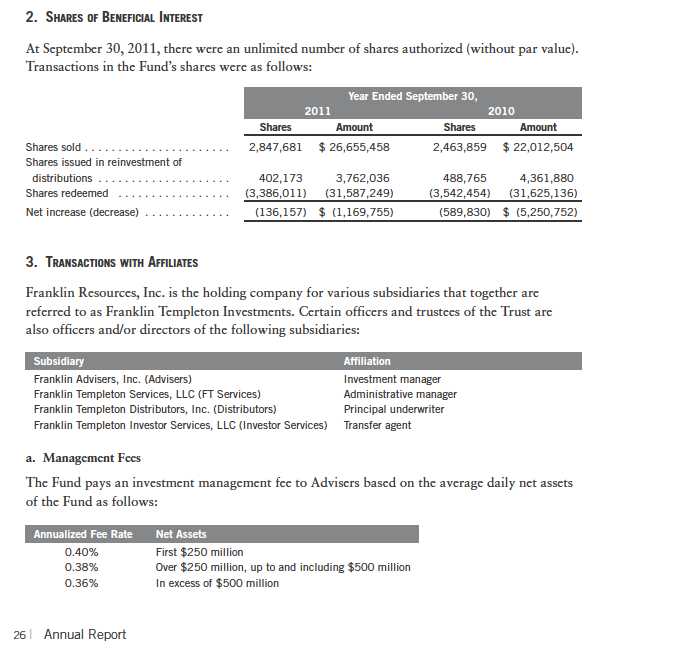
Franklin Strategic Mortgage Portfolio
Notes to Financial Statements (continued)
| 3. | TRANSACTIONS WITH AFFILIATES (continued) |
| b. | Administrative Fees |
Under an agreement with Advisers, FT Services provides administrative services to the Fund. The fee is paid by Advisers based on average daily net assets, and is not an additional expense of the Fund.
c. Sales Charges/Underwriting Agreements
Front-end sales charges and contingent deferred sales charges (CDSC) do not represent expenses of the Fund. These charges are deducted from the proceeds of sales of Fund shares prior to investment or from redemption proceeds prior to remittance, as applicable. Distributors has advised the Fund of the following commission transactions related to the sales and redemptions of the Fund’s shares for the year:

d. Transfer Agent Fees
For the year ended September 30, 2011, the Fund paid transfer agent fees of $135,958, of which $71,474 was retained by Investor Services.
4. EXPENSE OFFSET ARRANGEMENT
The Fund has entered into an arrangement with its custodian whereby credits realized as a result of uninvested cash balances are used to reduce a portion of the Fund’s custodian expenses. During the year ended September 30, 2011, there were no credits earned.
5. INCOME TAXES
For tax purposes, capital losses may be carried over to offset future capital gains, if any. At September 30, 2011, the capital loss carryforwards were as follows:
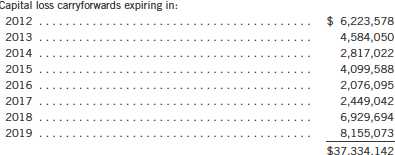
Annual Report | 27
Franklin Strategic Mortgage Portfolio
Notes to Financial Statements (continued)
5. INCOME TAXES (continued)
Under the Regulated Investment Company Modernization Act of 2010, the Fund will be permitted to carry forward capital losses incurred in taxable years beginning after December 22, 2010 for an unlimited period. Post-enactment capital loss carryforwards will retain their character as either short-term or long-term capital losses rather than being considered short-term as under previous law. Any post-enactment capital losses generated will be required to be utilized prior to the losses incurred in pre-enactment tax years.
For tax purposes, realized capital losses occurring subsequent to October 31 may be deferred and treated as occurring on the first day of the following fiscal year. At September 30, 2011, the Fund deferred realized capital losses of $50,529.
The tax character of distributions paid during the years ended September 30, 2011 and 2010, was as follows:
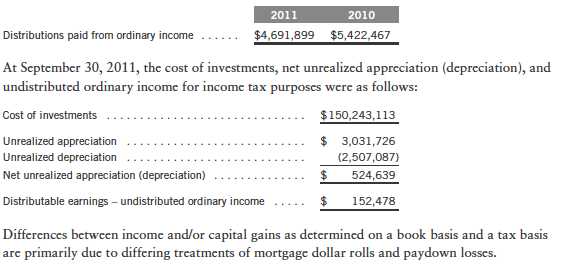
6. INVESTMENT TRANSACTIONS
Purchases and sales of investments (excluding short term securities) for the year ended September 30, 2011, aggregated $654,086,389 and $650,616,904, respectively.
7. INVESTMENTS IN INSTITUTIONAL FIDUCIARY TRUST MONEY MARKET PORTFOLIO
The Fund invests in the Institutional Fiduciary Trust Money Market Portfolio (Sweep Money Fund), an open-end investment company managed by Advisers. Management fees paid by the Fund are reduced on assets invested in the Sweep Money Fund, in an amount not to exceed the management and administrative fees paid by the Sweep Money Fund.
28 | Annual Report
Franklin Strategic Mortgage Portfolio
Notes to Financial Statements (continued)
8. CONCENTRATION OF CREDIT RISK
The Fund has 16.0% of its portfolio invested in asset-backed and commercial mortgage-backed securities. Investments in these securities may subject the Fund to increased market volatility which may cause the Fund’s net asset value per share to fluctuate. These investments may be less liquid than other investments held by the Fund.
9. OTHER DERIVATIVE INFORMATION
At September 30, 2011, the Fund has invested in derivative contracts which are reflected on the Statement of Assets and Liabilities as follows:
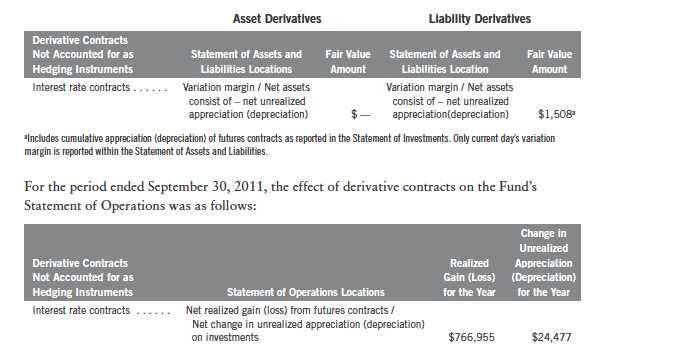
For the year ended September 30, 2011, the average month end market value of derivatives represented 0.03% of average month end net assets. The average month end number of open derivative contracts for the year was 1.
See Note 1(e) regarding derivative financial instruments.
10. CREDIT FACILITY
The Fund, together with other U.S. registered and foreign investment funds (collectively, Borrowers), managed by Franklin Templeton Investments, are borrowers in a joint syndicated senior unsecured credit facility totaling $750 million (Global Credit Facility) which matures on January 20, 2012. This Global Credit Facility provides a source of funds to the Borrowers for
Annual Report | 29
Franklin Strategic Mortgage Portfolio
Notes to Financial Statements (continued)
10. CREDIT FACILITY (continued)
temporary and emergency purposes, including the ability to meet future unanticipated or unusually large redemption requests.
Under the terms of the Global Credit Facility, the Fund shall, in addition to interest charged on any borrowings made by the Fund and other costs incurred by the Fund, pay its share of fees and expenses incurred in connection with the implementation and maintenance of the Global Credit Facility, based upon its relative share of the aggregate net assets of all of the Borrowers, including an annual commitment fee of 0.08% based upon the unused portion of the Global Credit Facility, which is reflected in other expenses on the Statement of Operations. During the year ended September 30, 2011, the Fund did not use the Global Credit Facility.
11. FAIR VALUE MEASUREMENTS
The Fund follows a fair value hierarchy that distinguishes between market data obtained from independent sources (observable inputs) and the Fund’s own market assumptions (unobservable inputs). These inputs are used in determining the value of the Fund’s investments and are summarized in the following fair value hierarchy:
- Level 1 – quoted prices in active markets for identical securities
- Level 2 – other significant observable inputs (including quoted prices for similar securities, interest rates, prepayment speed, credit risk, etc.)
- Level 3 – significant unobservable inputs (including the Fund’s own assumptions in determining the fair value of investments)
The inputs or methodology used for valuing securities are not an indication of the risk associated with investing in those securities.
For movements between the levels within the fair value hierarchy, the Fund has adopted a policy of recognizing the transfers as of the date of the underlying event which caused the movement.
The following is a summary of the inputs used as of September 30, 2011, in valuing the Fund’s assets and liabilities carried at fair value:
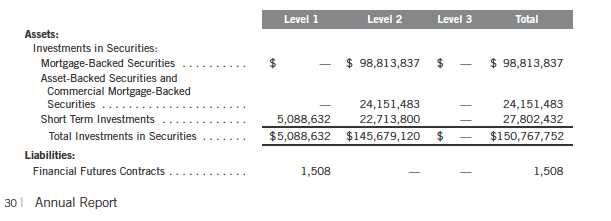
Franklin Strategic Mortgage Portfolio
Notes to Financial Statements (continued)
12. NEW ACCOUNTING PRONOUNCEMENTS
In April 2011, the Financial Accounting Standards Board (FASB) issued Accounting Standards Update (ASU) No. 2011-03, Transfers and Servicing (Topic 860): Reconsideration of Effective Control for Repurchase Agreements with the main objective to improve the accounting for repurchase agreements and other similar agreements that both entitle and obligate a transferor to repurchase or redeem financial assets before their maturity. The ASU modifies the criteria for determining effective control of transferred assets and as a result, certain agreements may now be accounted for as secured borrowings. The ASU is effective for transactions occurring in interim and annual periods beginning after December 15, 2011. The Fund is currently reviewing the requirements and believe the adoption of this ASU will not have a material impact on the financial statements.
In May 2011, FASB issued ASU No. 2011-04, Fair Value Measurement (Topic 820): Amendments to Achieve Common Fair Value Measurement and Disclosure Requirements in U.S. GAAP and IFRSs. The amendments in the ASU will improve the comparability of fair value measurements presented and disclosed in financial statements prepared in accordance with U.S. GAAP (Generally Accepted Accounting Principles) and IFRS (International Financial Reporting Standards) and include new guidance for certain fair value measurement principles and disclosure requirements. The ASU is effective for interim and annual periods beginning after December 15, 2011. The Fund is currently reviewing the requirements and believe the adoption of this ASU will not have a material impact on the financial statements.
13. SUBSEQUENT EVENTS
The Fund has evaluated subsequent events through the issuance of the financial statements and determined that no events have occurred that require disclosure.

Annual Report | 31
Franklin Strategic Mortgage Portfolio
Report of Independent Registered Public Accounting Firm
To the Board of Trustees and Shareholders of Franklin Strategic Mortgage Portfolio
In our opinion, the accompanying statement of assets and liabilities, including the statement of investments, and the related statements of operations and of changes in net assets and the financial highlights present fairly, in all material respects, the financial position of Franklin Strategic Mortgage Portfolio (the “Fund”) at September 30, 2011, the results of its operations for the year then ended, the changes in its net assets for each of the two years in the period then ended and the financial highlights for each of the five years in the period then ended, in conformity with accounting principles generally accepted in the United States of America. These financial statements and financial highlights (hereafter referred to as “financial statements”) are the responsibility of the Fund’s management. Our responsibility is to express an opinion on these financial statements based on our audits. We conducted our audits of these financial statements in accordance with the standards of the Public Company Accounting Oversight Board (United States). Those standards require that we plan and perform the audit to obtain reasonable assurance about whether the financial statements are free of material misstatement. An audit includes examining, on a test basis, evidence supporting the amounts and disclosures in the financial statements, assessing the accounting principles used and significant estimates made by management, and evaluating the overall financial statement presentation. We believe that our audits, which included confirmation of securities at September 30, 2011 by correspondence with the custodian and brokers, provide a reasonable basis for our opinion.
PricewaterhouseCoopers LLP
San Francisco, California
November 16, 2011
32 | Annual Report
Franklin Strategic Mortgage Portfolio
Tax Designation (unaudited)
Under Section 871(k)(1)(C) of the Internal Revenue Code (Code), the Fund designates the maximum amount allowable but no less than $3,450,283 as interest related dividends for purposes of the tax imposed under Section 871(a)(1)(A) of the Code for the fiscal year ended September 30, 2011.
Annual Report | 33
Franklin Strategic Mortgage Portfolio
Board Members and Officers
The name, year of birth and address of the officers and board members, as well as their affiliations, positions held with the Trust, principal occupations during the past five years and number of portfolios overseen in the Franklin Templeton Investments fund complex are shown below. Generally, each board member serves until that person’s successor is elected and qualified.
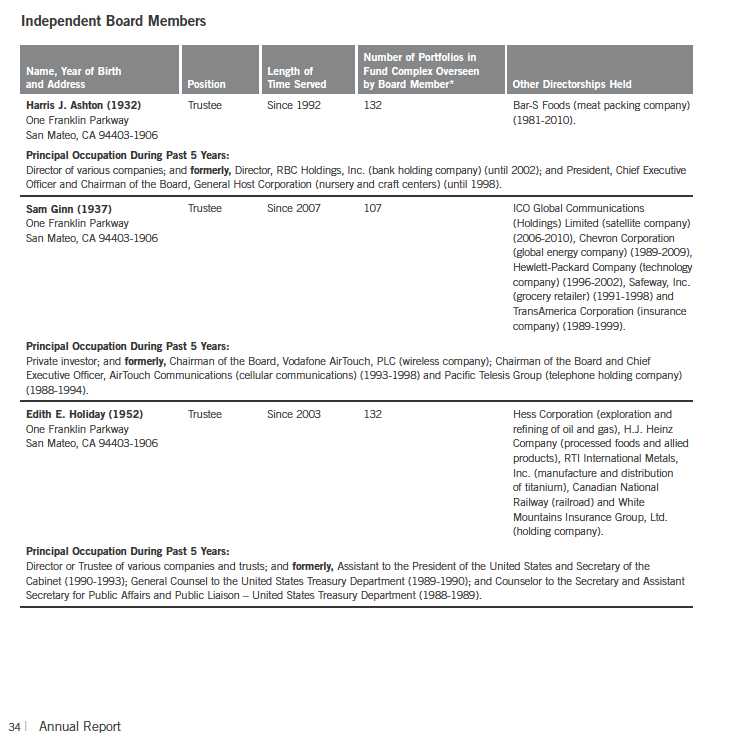
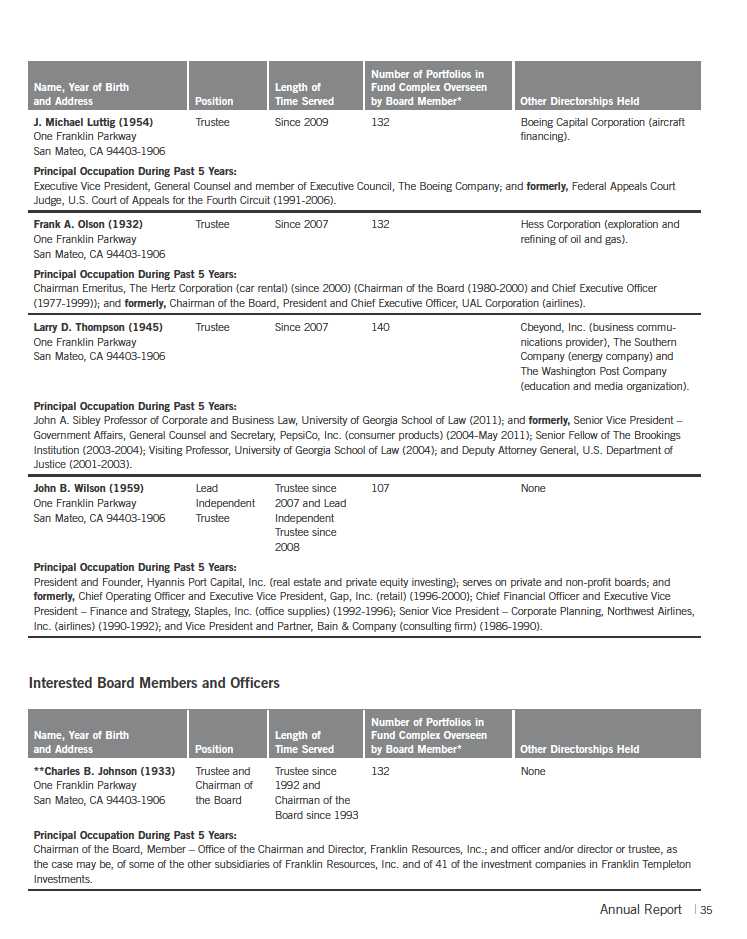
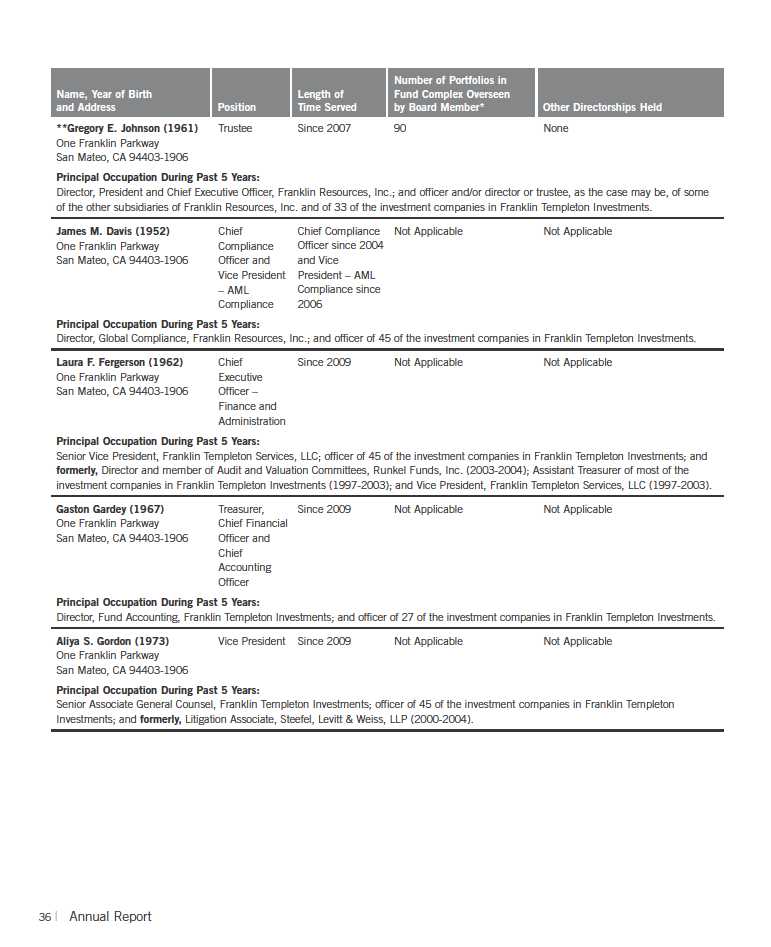
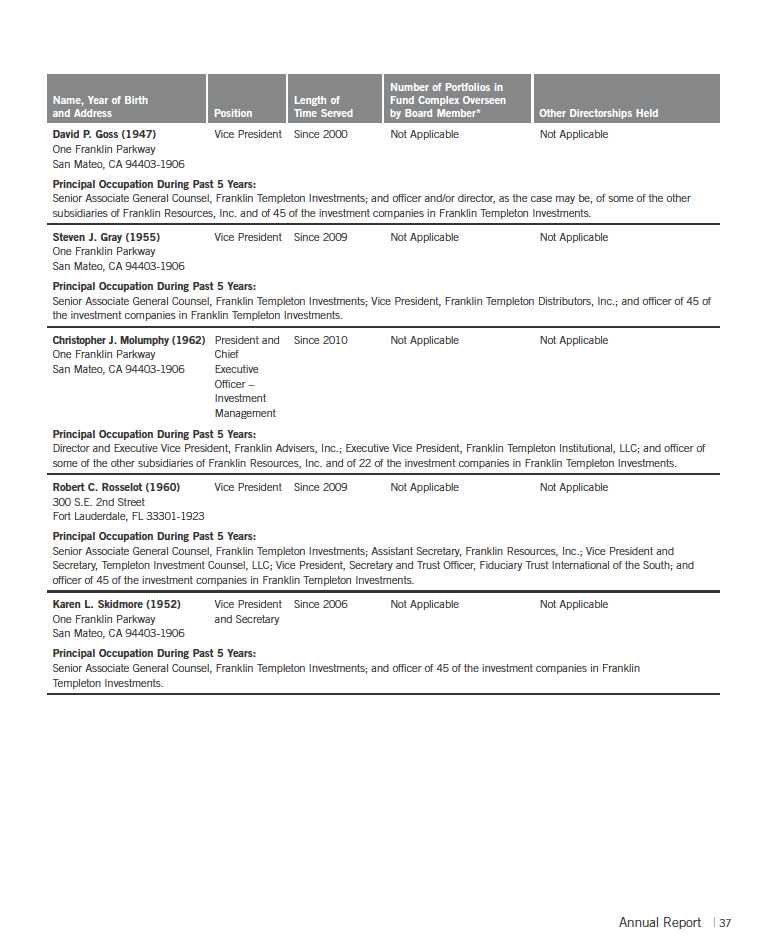
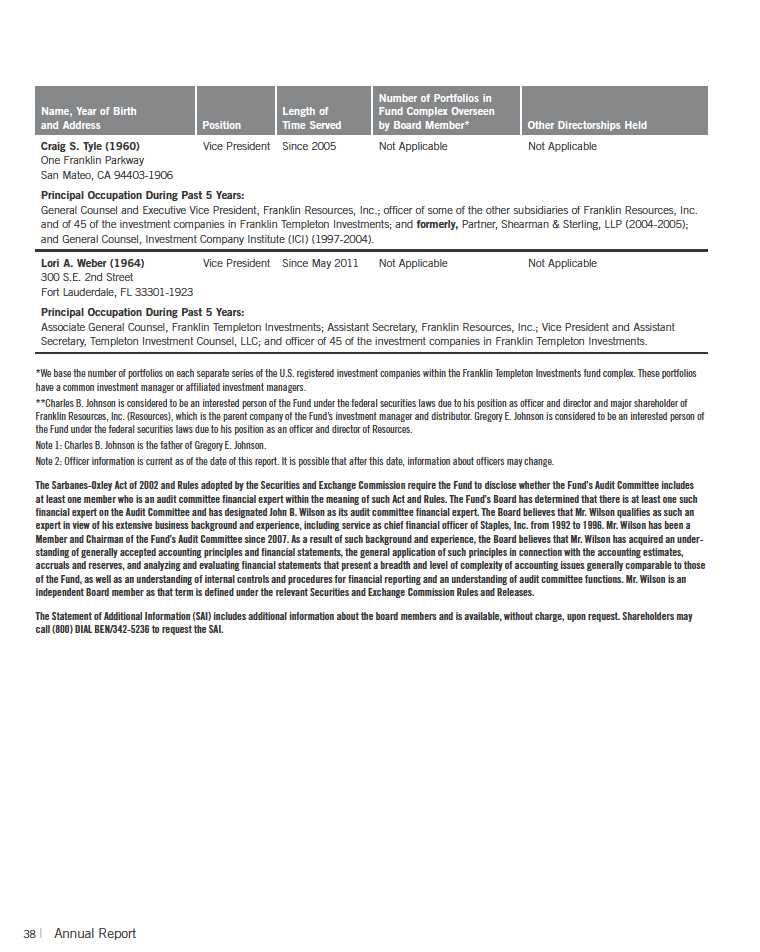
Franklin Strategic Mortgage Portfolio
Shareholder Information
Proxy Voting Policies and Procedures
The Trust’s investment manager has established Proxy Voting Policies and Procedures (Policies) that the Trust uses to determine how to vote proxies relating to portfolio securities. Shareholders may view the Trust’s complete Policies online at franklintempleton.com. Alternatively, shareholders may request copies of the Policies free of charge by calling the Proxy Group collect at (954) 527-7678 or by sending a written request to: Franklin Templeton Companies, LLC, 300 S.E. 2nd Street, Fort Lauderdale, FL 33301, Attention: Proxy Group. Copies of the Trust’s proxy voting records are also made available online at franklintempleton.com and posted on the U.S. Securities and Exchange Commission’s website at sec.gov and reflect the most recent 12-month period ended June 30.
Quarterly Statement of Investments
The Trust files a complete statement of investments with the U.S. Securities and Exchange Commission for the first and third quarters for each fiscal year on Form N-Q. Shareholders may view the filed Form N-Q by visiting the Commission’s website at sec.gov. The filed form may also be viewed and copied at the Commission’s Public Reference Room in Washington, DC. Information regarding the operations of the Public Reference Room may be obtained by calling (800) SEC-0330.
Householding of Reports and Prospectuses
You will receive the Fund’s financial reports every six months as well as an annual updated summary prospectus (prospectus available upon request). To reduce Fund expenses, we try to identify related shareholders in a household and send only one copy of the financial reports and summary prospectus. This process, called “householding,” will continue indefinitely unless you instruct us otherwise. If you prefer not to have these documents householded, please call us at (800) 632-2301. At any time you may view current prospectuses/summary prospectuses and financial reports on our website. If you choose, you may receive these documents through electronic delivery.
Annual Report | 39
This page intentionally left blank.
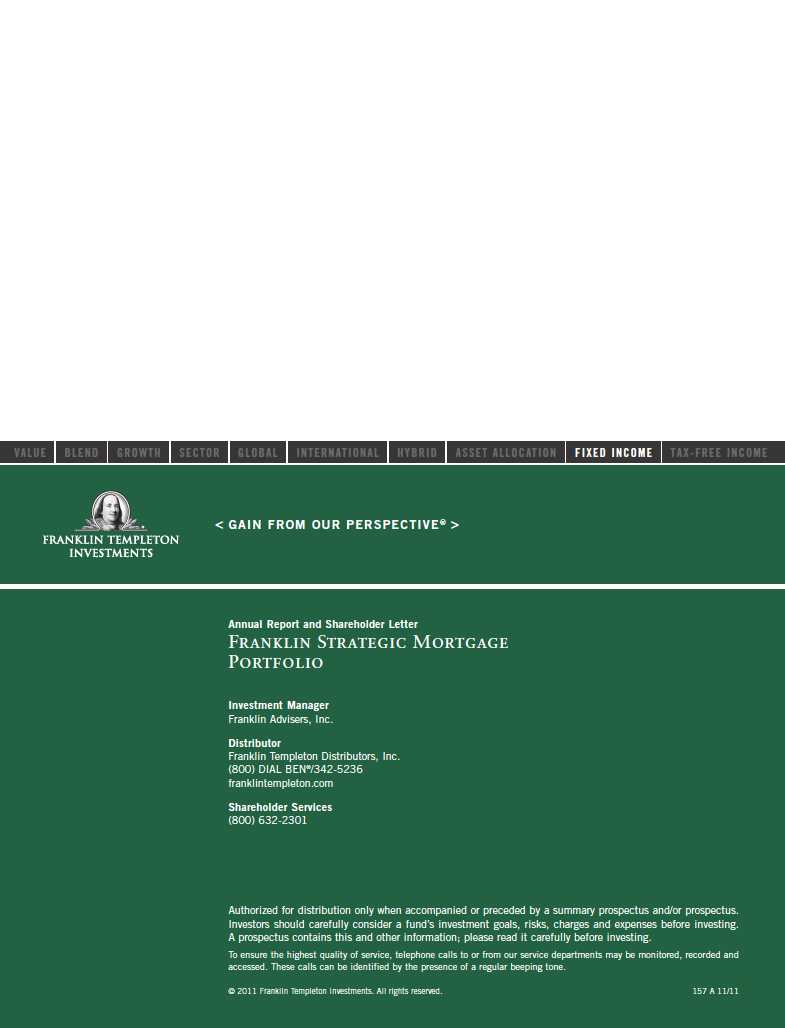
Item 2. Code of Ethics.
(a) The Registrant has adopted a code of ethics that applies to its principal executive officers and principal financial and accounting officer.
| (c) | N/A |
| (d) | N/A |
| (f) | Pursuant to Item 12(a)(1), the Registrant is attaching as an |
exhibit a copy of its code of ethics that applies to its principal executive officers and principal financial and accounting officer.
Item 3. Audit Committee Financial Expert.
(a)(1) The Registrant has an audit committee financial expert serving on its audit committee.
(2) The audit committee financial expert is John B. Wilson and he is "independent" as defined under the relevant Securities and Exchange Commission Rules and Releases.
Item 4. Principal Accountant Fees and Services.
(a) Audit Fees
The aggregate fees paid to the principal accountant for professional services rendered by the principal accountant for the audit of the registrant’s annual financial statements or for services that are normally provided by the principal accountant in connection with statutory and regulatory filings or engagements were $26,956 for the fiscal year ended September 30, 2011 and $27,193 for the fiscal year ended September 30, 2010.
(b) Audit-Related Fees
There were no fees paid to the principal accountant for assurance and related services rendered by the principal accountant to the registrant that are reasonably related to the performance of the audit of the registrant's financial statements and are not reported under paragraph (a) of Item 4.
There were no fees paid to the principal accountant for assurance and related services rendered by the principal accountant to the registrant's investment adviser and any entity controlling, controlled by or under common control with the investment adviser that provides ongoing services to the registrant that are reasonably related to the performance of the audit of their financial statements.
(c) Tax Fees
There were no fees paid to the principal accountant for professional services rendered by the principal accountant to the registrant for tax compliance, tax advice and tax planning.
The aggregate fees paid to the principal accountant for professional services rendered by the principal accountant to the registrant’s investment adviser and any entity controlling, controlled by or under common control with the investment adviser that provides ongoing services to the registrant for tax compliance, tax advice and tax planning were $75,000 for the fiscal year ended September 30, 2011 and $35,000 for the fiscal year ended September 30, 2010. The services for which these fees were paid included technical tax consultation for capital gain tax reporting to foreign governments and the application of the local country tax laws to investments made by various Franklin Templeton funds.
(d) All Other Fees
The aggregate fees paid to the principal accountant for products and services rendered by the principal accountant to the registrant not reported in paragraphs (a)-(c) of Item 4 were $0 for the fiscal year ended September 30, 2011 and $37 for the fiscal year ended September 30, 2010. The services for which these fees were paid include review of materials provided to the fund Board in connection with the investment management contract renewal process.
The aggregate fees paid to the principal accountant for products and services rendered by the principal accountant to the registrant’s investment adviser and any entity controlling, controlled by or under common control with the investment adviser that provides ongoing services to the registrant not reported in paragraphs (a)-(c) of Item 4 were $0 for the fiscal year ended September 30, 2011 and $144,763 for the fiscal year ended September 30, 2010. The services for which these fees were paid include review of materials provided to the fund Board in connection with the investment management contract renewal process.
(e) (1) The registrant’s audit committee is directly responsible for approving the services to be provided by the auditors, including:
| (i) | pre-approval of all audit and audit related services; |
| (ii) | pre-approval of all non-audit related services to be |
provided to the Fund by the auditors;
(iii) pre-approval of all non-audit related services to be provided to the registrant by the auditors to the registrant’s investment adviser or to any entity that controls, is controlled by or is under common control with the registrant’s investment adviser and that provides ongoing services to the registrant where the non-audit services relate directly to the operations or financial reporting of the registrant; and
(iv) establishment by the audit committee, if deemed necessary or appropriate, as an alternative to committee pre-approval of services to be provided by the auditors, as required by paragraphs (ii) and (iii) above, of policies and procedures to permit such services to be pre-approved by other means, such as through establishment of guidelines or by action of a designated member or members of the committee; provided the policies and procedures are detailed as to the particular service and the committee is informed of each service and such policies and procedures do not include delegation of audit
committee responsibilities, as contemplated under the Securities Exchange Act of 1934, to management; subject, in the case of (ii) through (iv), to any waivers, exceptions or exemptions that may be available under applicable law or rules.
(e) (2) None of the services provided to the registrant described in paragraphs (b)-(d) of Item 4 were approved by the audit committee pursuant to paragraph (c)(7)(i)(C) of Rule 2-01 of regulation S-X.
| (f) | No disclosures are required by this Item 4(f). |
| (g) | The aggregate non-audit fees paid to the principal accountant for |
services rendered by the principal accountant to the registrant and the registrant’s investment adviser and any entity controlling, controlled by or under common control with the investment adviser that provides ongoing services to the registrant were $75,000 for the fiscal year ended September 30, 2011 and $179,800 for the fiscal year ended September 30, 2010.
(h) The registrant’s audit committee of the board has considered whether the provision of non-audit services that were rendered to the registrant’s investment adviser (not including any sub-adviser whose role is primarily portfolio management and is subcontracted with or overseen by another investment adviser), and any entity controlling, controlled by, or under common control with the investment adviser that provides ongoing services to the registrant that were not pre-approved pursuant to paragraph (c)(7)(ii) of Rule 2-01 of Regulation S-X is compatible with maintaining the principal accountant’s independence.
Item 5. Audit Committee of Listed Registrants. Item 6. Schedule of Investments. | N/A N/A |
Item 7. Disclosure of Proxy Voting Policies and Procedures for Closed-
| End Management Investment Companies. | N/A |
| Item 8. Portfolio Managers of Closed-End Management Investment | |
| Companies. | N/A |
| Item 9. Purchases of Equity Securities by Closed-End Management | |
| Investment Company and Affiliated Purchasers. | N/A |
Item 10. Submission of Matters to a Vote of Security Holders.
There have been no changes to the procedures by which shareholders may recommend nominees to the Registrant's Board of Trustees that would require disclosure herein.
Item 11. Controls and Procedures.
(a) Evaluation of Disclosure Controls and Procedures. The Registrant maintains disclosure controls and procedures that are designed to ensure that information required to be disclosed in the Registrant’s filings under the Securities Exchange Act of 1934 and the Investment Company Act of 1940 is recorded, processed, summarized and reported within the periods specified in the rules and forms of the Securities and Exchange Commission. Such information is accumulated and communicated to the Registrant’s management, including its principal executive officer and principal financial officer, as appropriate, to allow timely decisions regarding required disclosure. The Registrant’s management, including the principal executive officer and the principal financial officer, recognizes that any set of controls and procedures, no matter how well designed and operated, can provide only reasonable assurance of achieving the desired control objectives.
Within 90 days prior to the filing date of this Shareholder Report on Form N-CSR, the Registrant had carried out an evaluation, under the supervision and with the participation of the Registrant’s management, including the Registrant’s principal executive officer and the Registrant’s principal financial officer, of the effectiveness of the design and operation of the Registrant’s disclosure controls and procedures. Based on such evaluation, the Registrant’s principal executive officer and principal financial officer concluded that the Registrant’s disclosure controls and procedures are effective.
(b) Changes in Internal Controls.
There have been no significant
changes in the Registrant’s internal controls or in other factors that could significantly affect the internal controls subsequent to the date of their evaluation in connection with the preparation of this Shareholder Report on Form N-CSR.
Item 12. Exhibits.
| (a) | (1) Code of Ethics |
| (a) | (2) Certifications pursuant to Section 302 of the Sarbanes-Oxley |
Act of 2002 of Laura F. Fergerson, Chief Executive Officer - Finance and Administration, and Gaston Gardey, Chief Financial Officer and Chief Accounting Officer
(b) Certifications pursuant to Section 906 of the Sarbanes-Oxley Act of 2002 of Laura F. Fergerson, Chief Executive Officer - Finance and Administration, and Gaston Gardey, Chief Financial Officer and Chief Accounting Officer
SIGNATURES
Pursuant to the requirements of the Securities Exchange Act of 1934 and the Investment Company Act of 1940, the registrant has duly caused this report to be signed on its behalf by the undersigned, thereunto duly authorized.
FRANKLIN STRATEGIC MORTGAGE PORTFOLIO
By /s/ Laura F. Fergerson
Laura F. Fergerson
Chief Executive Officer - Finance and Administration
Date November 25, 2011
Pursuant to the requirements of the Securities Exchange Act of 1934 and
the Investment Company Act of 1940, this report has been signed below
by the following persons on behalf of the registrant and in the
capacities and on the dates indicated.
By /s/ Laura F. Fergerson
Laura F. Fergerson
Chief Executive Officer - Finance and Administration
Date November 25, 2011
By /s/ Gaston Gardey
Gaston Gardey
Chief Financial Officer and
Chief Accounting Officer
Date November 25, 2011